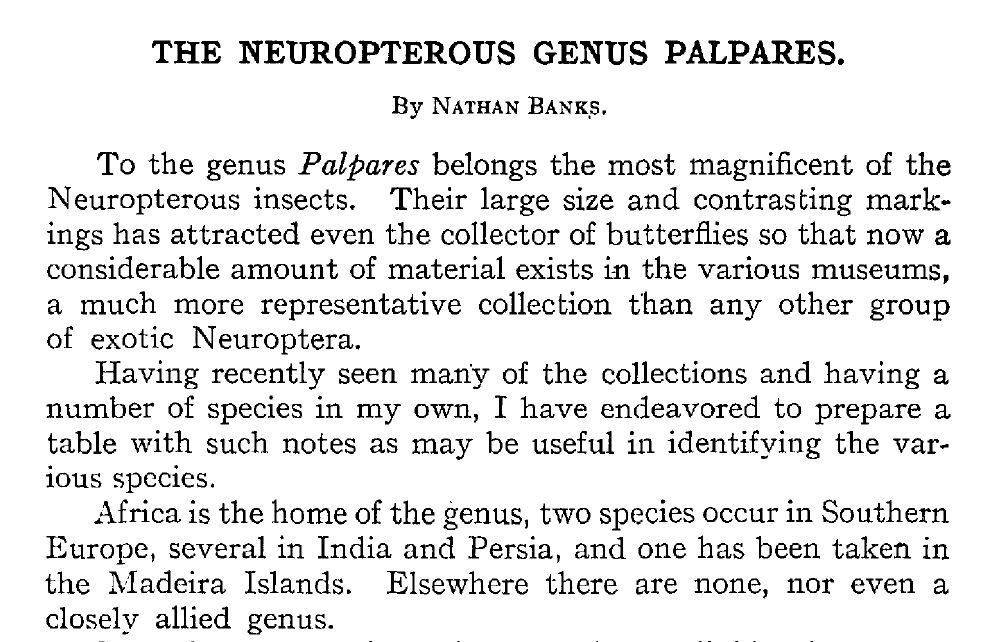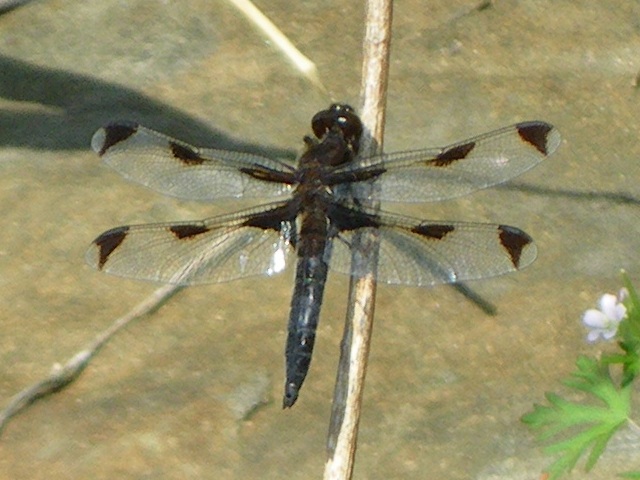|
Palpares Libelluloides
''Palpares libelluloides'' is a species of antlion in the genus ''Palpares'' belonging to the family Myrmeleontidae . It is found across Southern Europe. Description ''Palpares libelluloides'' has a relatively large wingspan of more than . The very broad wings are mottled dark brown. The males can be recognized by their long, delicate genital appendages. The day-and night-active imagos can be observed from May to September. Their flight is usually short and close to the ground. The specific name ''libelluloides'' means "dragonfly-like" (cf the dragonfly genus ''Libellula ''Libellula'' is a genus of dragonflies, commonly called skimmers, in the family Libellulidae, distributed throughout the temperate zone of the Northern Hemisphere. Most species are found in the United States, where they are the best-known larg ...''). Distribution This species is widespread in the Mediterranean regions and it is mainly present in Albania, Bulgaria, France, Greece, Hungary, Italy, Rom ... [...More Info...] [...Related Items...] OR: [Wikipedia] [Google] [Baidu] |
Pletvar
Pletvar is a village in Municipality of Prilep, North Macedonia. The critically endangered Macedonian grayling butterfly is only found in the Pletvar area. Demographics According to the 2002 census, the village had a total of 22 inhabitants. Ethnic groups in the village include:Macedonian Census (2002) ''Book 5 - Total population according to the Ethnic Affiliation, Mother Tongue and Religion'' The State Statistical Office, Skopje, 2002, p. 156. * Macedonians 21 *Serbs The Serbs ( sr-Cyr, Срби, Srbi, ) are the most numerous South Slavic ethnic group native to the Balkans in Southeastern Europe, who share a common Serbian ancestry, culture, history and language. The majority of Serbs live in their na ... 1 References Villages in Prilep Municipality {{Prilep-geo-stub ... [...More Info...] [...Related Items...] OR: [Wikipedia] [Google] [Baidu] |
North Macedonia
North Macedonia, ; sq, Maqedonia e Veriut, (Macedonia before February 2019), officially the Republic of North Macedonia,, is a country in Southeast Europe. It gained independence in 1991 as one of the successor states of Socialist Federal Republic of Yugoslavia, Yugoslavia. It is a landlocked country bordering Kosovo to the northwest, Serbia to the north, Bulgaria to the east, Greece to the south, and Albania to the west. It constitutes approximately the northern third of the larger geographical Macedonia (region), region of Macedonia. Skopje, the capital and largest city, is home to a quarter of the country's 1.83 million people. The majority of the residents are ethnic Macedonians (ethnic group), Macedonians, a South Slavs, South Slavic people. Albanians in North Macedonia, Albanians form a significant minority at around 25%, followed by Turks in North Macedonia, Turks, Romani people in North Macedonia, Romani, Serbs in North Macedonia, Serbs, Bosniaks in North Mac ... [...More Info...] [...Related Items...] OR: [Wikipedia] [Google] [Baidu] |
Carl Linnaeus
Carl Linnaeus (; 23 May 1707 – 10 January 1778), also known after his ennoblement in 1761 as Carl von Linné Blunt (2004), p. 171. (), was a Swedish botanist, zoologist, taxonomist, and physician who formalised binomial nomenclature, the modern system of naming organisms. He is known as the "father of modern taxonomy". Many of his writings were in Latin; his name is rendered in Latin as and, after his 1761 ennoblement, as . Linnaeus was born in Råshult, the countryside of Småland, in southern Sweden. He received most of his higher education at Uppsala University and began giving lectures in botany there in 1730. He lived abroad between 1735 and 1738, where he studied and also published the first edition of his ' in the Netherlands. He then returned to Sweden where he became professor of medicine and botany at Uppsala. In the 1740s, he was sent on several journeys through Sweden to find and classify plants and animals. In the 1750s and 1760s, he continued to collect an ... [...More Info...] [...Related Items...] OR: [Wikipedia] [Google] [Baidu] |
Antlion
The antlions are a group of about 2,000 species of insect in the neuropteran family Myrmeleontidae. They are known for the predatory habits of their larvae, which mostly dig pits to trap passing ants or other prey. In North America, the larvae are sometimes referred to as doodlebugs because of the marks they leave in the sand. The adult insects are less well known due to their relatively short lifespans compared to the larvae. Adults, sometimes known as antlion lacewings, mostly fly at dusk or after dark and may be mistakenly identified as dragonflies or damselflies. Antlions have a worldwide distribution. The greatest diversity occurs in the tropics, but a few species are found in cold-temperate locations, one such being the European ''Euroleon nostras''. They most commonly occur in dry and sandy habitats where the larvae can easily excavate their pits, but some larvae hide under debris or ambush their prey among leaf litter. Antlions are poorly represented in the fossil rec ... [...More Info...] [...Related Items...] OR: [Wikipedia] [Google] [Baidu] |
Palpares
''Palpares'' is an antlion genus in the Myrmeleontidae family. Species * '' Palpares abyssinicus'' * '' Palpares adspersus'' * '' Palpares aegrotus'' * '' Palpares aeschnoides'' * '' Palpares alopecinus'' * '' Palpares amitinus'' * '' Palpares angustus'' * '' Palpares apicatus'' * '' Palpares arcangelii'' * '' Palpares astarte'' * '' Palpares auratus'' * '' Palpares bayoni'' * '' Palpares caffer'' * ''Palpares campanai'' * '' Palpares cataractae'' * '' Palpares cephalotes'' * ''Palpares cognatus'' * ''Palpares contrarius'' * ''Palpares decaryi'' * ''Palpares digitatus'' * ''Palpares dispar'' * ''Palpares elegantulus'' * ''Palpares falcatus'' * ''Palpares fulvus'' * ''Palpares geniculatus'' * ''Palpares germaini'' * ''Palpares gratiosus'' * '' Palpares hispanus'' * '' Palpares immensus'' * '' Palpares inclemens'' * '' Palpares incommodus'' * '' Palpares infimus'' * '' Palpares insularis'' * '' Palpares kalahariensis'' * '' Palpares karrooanus'' * '' Palpares lentus'' * ''Palpare ... [...More Info...] [...Related Items...] OR: [Wikipedia] [Google] [Baidu] |
Myrmeleontidae
The antlions are a group of about 2,000 species of insect in the neuropteran family Myrmeleontidae. They are known for the predatory habits of their larvae, which mostly dig pits to trap passing ants or other prey. In North America, the larvae are sometimes referred to as doodlebugs because of the marks they leave in the sand. The adult insects are less well known due to their relatively short lifespans compared to the larvae. Adults, sometimes known as antlion lacewings, mostly fly at dusk or after dark and may be mistakenly identified as dragonflies or damselflies. Antlions have a worldwide distribution. The greatest diversity occurs in the tropics, but a few species are found in cold-temperate locations, one such being the European ''Euroleon nostras''. They most commonly occur in dry and sandy habitats where the larvae can easily excavate their pits, but some larvae hide under debris or ambush their prey among leaf litter. Antlions are poorly represented in the fossil re ... [...More Info...] [...Related Items...] OR: [Wikipedia] [Google] [Baidu] |
Myrmeleonidae - Palpares Libelluloides
The antlions are a group of about 2,000 species of insect in the neuropteran family Myrmeleontidae. They are known for the predatory habits of their larvae, which mostly dig pits to trap passing ants or other prey. In North America, the larvae are sometimes referred to as doodlebugs because of the marks they leave in the sand. The adult insects are less well known due to their relatively short lifespans compared to the larvae. Adults, sometimes known as antlion lacewings, mostly fly at dusk or after dark and may be mistakenly identified as dragonflies or damselflies. Antlions have a worldwide distribution. The greatest diversity occurs in the tropics, but a few species are found in cold-temperate locations, one such being the European ''Euroleon nostras''. They most commonly occur in dry and sandy habitats where the larvae can easily excavate their pits, but some larvae hide under debris or ambush their prey among leaf litter. Antlions are poorly represented in the fossil re ... [...More Info...] [...Related Items...] OR: [Wikipedia] [Google] [Baidu] |
Wingspan
The wingspan (or just span) of a bird or an airplane is the distance from one wingtip to the other wingtip. For example, the Boeing 777–200 has a wingspan of , and a wandering albatross (''Diomedea exulans'') caught in 1965 had a wingspan of , the official record for a living bird. The term wingspan, more technically extent, is also used for other winged animals such as pterosaurs, bats, insects, etc., and other aircraft such as ornithopters. In humans, the term wingspan also refers to the arm span, which is distance between the length from one end of an individual's arms (measured at the fingertips) to the other when raised parallel to the ground at shoulder height at a 90º angle. Former professional basketball player Manute Bol stood at and owned one of the largest wingspans at . Wingspan of aircraft The wingspan of an aircraft is always measured in a straight line, from wingtip to wingtip, independently of wing shape or sweep. Implications for aircraft design and anima ... [...More Info...] [...Related Items...] OR: [Wikipedia] [Google] [Baidu] |
Libellula
''Libellula'' is a genus of dragonflies, commonly called skimmers, in the family Libellulidae, distributed throughout the temperate zone of the Northern Hemisphere. Most species are found in the United States, where they are the best-known large dragonflies, often seen flying over freshwater ponds in summer. Many have showy wing patterns. Overview The taxa ''Ladona'' (corporals) and ''Plathemis'' (whitetails) have been considered as synonyms of ''Libellula'', subgenera, or separate genera by different authorities. Recent phylogenetic analysis has supported their status as either subgenera or full genera. Species List of species. funet.fi Extant species ''Ladona'' ''Plathemis'' Fossils *'' |
Neuroptera Of Europe
The insect order Neuroptera, or net-winged insects, includes the lacewings, mantidflies, antlions, and their relatives. The order consists of some 6,000 species. Neuroptera can be grouped together with the Megaloptera and Raphidioptera in the unranked taxon Neuropterida (once known as Planipennia) including: alderflies, fishflies, dobsonflies, and snakeflies. Adult Neuropterans have four membranous wings, all about the same size, with many veins. They have chewing mouthparts, and undergo complete metamorphosis. Neuropterans first appeared during the Permian period, and continued to diversify through the Mesozoic era. During this time, several unusually large forms evolved, especially in the extinct family Kalligrammatidae, often called "the butterflies of the Jurassic" for their large, patterned wings. Anatomy and biology Neuropterans are soft-bodied insects with relatively few specialized features. They have large lateral compound eyes, and may or may not also have ... [...More Info...] [...Related Items...] OR: [Wikipedia] [Google] [Baidu] |
Insects Described In 1764
Insects (from Latin ') are pancrustacean hexapod invertebrates of the class Insecta. They are the largest group within the arthropod phylum. Insects have a chitinous exoskeleton, a three-part body (head, thorax and abdomen), three pairs of jointed legs, compound eyes and one pair of antennae. Their blood is not totally contained in vessels; some circulates in an open cavity known as the haemocoel. Insects are the most diverse group of animals; they include more than a million described species and represent more than half of all known living organisms. The total number of extant species is estimated at between six and ten million; In: potentially over 90% of the animal life forms on Earth are insects. Insects may be found in nearly all environments, although only a small number of species reside in the oceans, which are dominated by another arthropod group, crustaceans, which recent research has indicated insects are nested within. Nearly all insects hatch from eggs. Insect ... [...More Info...] [...Related Items...] OR: [Wikipedia] [Google] [Baidu] |



_Macedonia.jpg)


